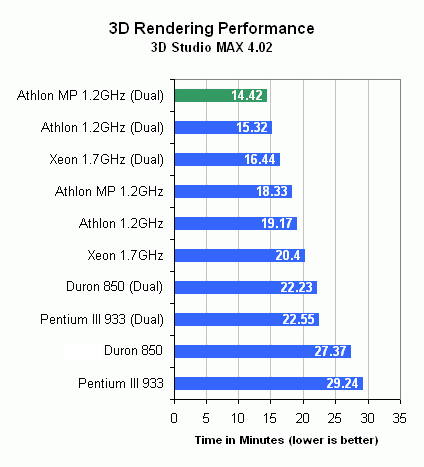AMD 760MP & Athlon MP - Dual Processor Heaven
by Anand Lal Shimpi on June 5, 2001 12:00 PM EST- Posted in
- CPUs
3D Rendering Performance
The 760MP with Athlon MP has started out on the right foot, taking the lead in database serving scenarios but what about playing a role in a high-end 3D workstation? Sticking with the real-world theme of our benchmarks we decided to explore another problem faced by one of our team members.
Just recently, AnandTech Senior Hardware Editor Matthew Witheiler had begun working under 3D Studio MAX on the creation and subsequent rendering of some pretty interesting 3D scenes. The biggest complain he had was that at 640 x 480, his scenes often took over two hours to render. While Matthew was just playing around with 3D Studio MAX, there are AnandTech readers out there that depend on high rendering performance for their jobs and actually use Kinetix's popular software package on a daily basis. If Matthew's fairly simple Space scene took 2 hours to render on a decently spec'd workstation, we can only imagine how long some of the more complicated scenes would take to render.
This brings us to our next benchmark, a 3D Studio MAX rendering test. The test scene consists of 4 objects total (2 spheres, a modified sphere, and a quad patch with noise modifiers) plus an omni light and a camera. Effects added to the scene are lens flare and lens glow on the omni light, and fire on the sun sphere. The asteroid (modified sphere) is set to have motion blur. The animation occurs over 300 frames and consists of moving the camera, rotating the planet, and moving and rotating the asteroid. The rendering is done in video post rendering so that the camera effects are added. AVI compression used is Cinepak Codec by Radius with a compression quality of 100. Size of movie is 320x240. Monitor was set to 32-bit color at 1024x768x32 and all boards were tested with GeForce2 Ultras. The program was set to use OpenGL and ran off of NVIDIA’s 12.01 drivers. 3D Studio MAX version 4.02 was used.
Performance here is dependent on not only a fast processor but a fast graphics subsystem; luckily 3D Studio MAX is multithreaded so it can easily take advantage of moving to multiple processors.
We've known that the Xeon (and Pentium 4) don't have the world's strongest FPUs and generally rely on SSE2 optimizations to deliver superior FPU performance, however the Dual Xeon platform does perform quite well in this test. Once again the Dual Athlon MP and this time around the Dual Athlon as well are able to outperform Intel's latest Xeon creation.
The Dual Athlon MP setup is able to complete the animation process in 94% of the time of the Dual Athlon 1.2 which continues to support the theory that the enhancements made in the Athlon MP core are definitely of some use in a lot of high-end applications.
The Duron 850 in dual again offers performance that is nearly identical to the Dual Pentium III 933 setup, but it also provides a much more flexible upgrade path since you can drop a pair of Athlons or Athlon MPs into a dual Duron system later on when CPU prices fall even further. The weak points of the Duron continue to be its slower FSB (200MHz effective vs. 266MHz effective) and its smaller cache (192KB vs. 384KB).











0 Comments
View All Comments